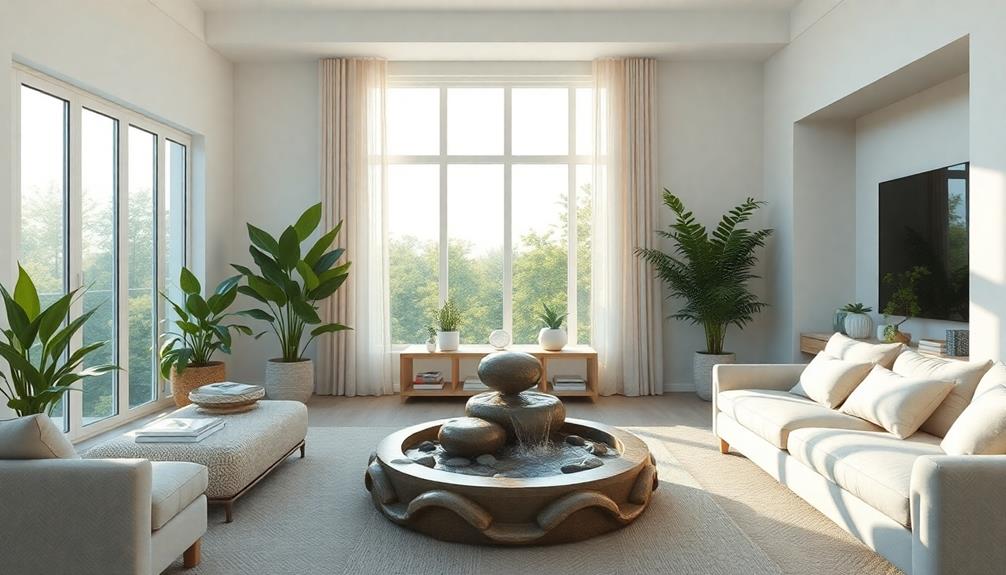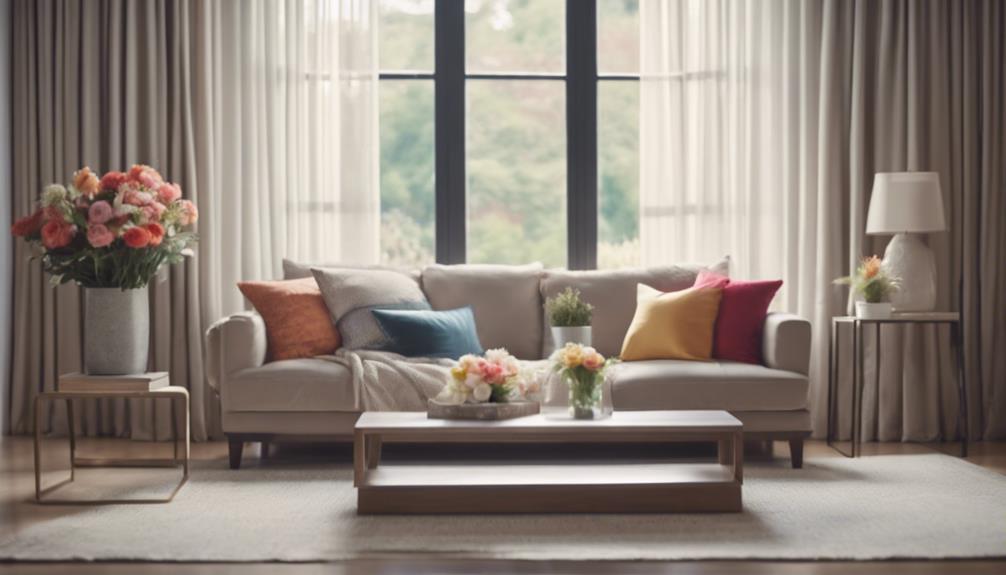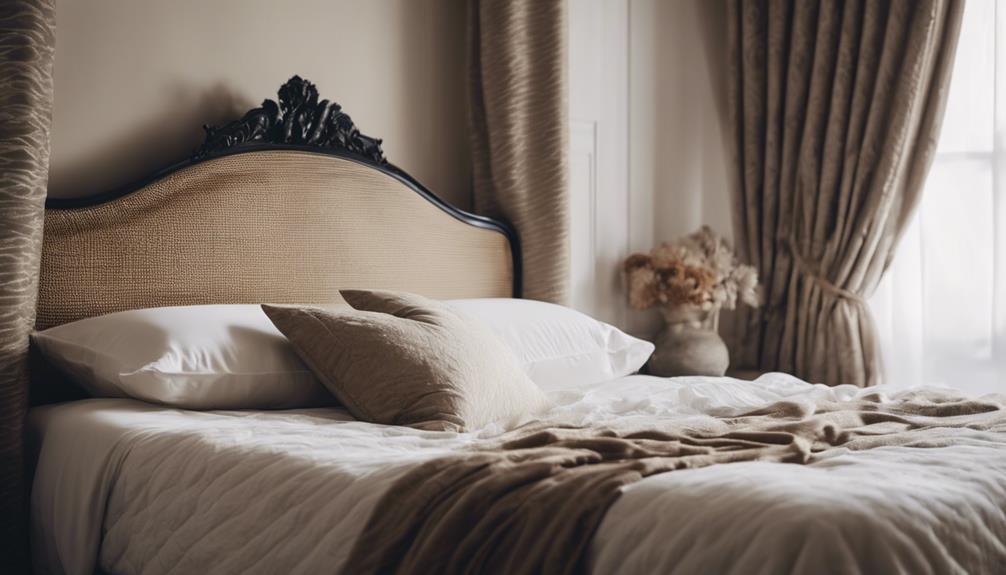Batik brings a new level of sophistication to contemporary homes, connecting you to centuries of cultural grace. This traditional art form brings a lively flair to your interior design, whether in the form of striking wall tapestries or vibrant upholstery. By incorporating batik accent pieces like cushions or table runners, you can effortlessly showcase its intricate patterns and cultural stories. It’s more than just decor; it’s a celebration of tradition that sparks admiration and dialogue. Embracing batik allows you to pay homage to heritage while enhancing your style. Continue to explore how this exquisite art form can turn your home into a culturally vibrant sanctuary.
Key Takeaways
- Batik represents a rich cultural heritage, showcasing traditional artistry that enhances modern home aesthetics and promotes cultural appreciation.
- Various batik techniques, like Batik Tulis and Batik Cap, offer unique patterns that reflect deep cultural narratives and artistry.
- Incorporating batik in home decor adds elegance through textiles, wall art, and furniture upholstery, creating inviting and vibrant spaces.
- Batik's global influence allows it to merge with contemporary design, enhancing diverse interior styles while honoring tradition.
- The integration of batik in modern homes supports cultural heritage preservation, fostering artisan skills and economic opportunities in communities.
Tracing Ancestral Roots

Batik, with its intricate patterns and vibrant colors, isn't just fabric; it's a living symbol of thousands of years of cultural heritage. As you explore batik, you'll discover its roots trace back over 2000 years, highlighting a rich history that spans continents.
While its exact origins are debated among Africa, India, Sri Lanka, and China, the technique flourished in Java, where natural materials came together to create stunning designs. The artistry of batik often parallels that of other traditional crafts, such as the unique designs of Indonesian decor masks, showcasing the diversity of cultural expression within the region.
Each piece of batik you encounter tells a story, reflecting the unique cultural narratives of various Indonesian regions. The intricate patterns serve as a visual language, conveying traditions, beliefs, and identities tied to the community that crafted them.
This labor-intensive process not only preserves ancient craftsmanship but also connects you to a larger cultural heritage. As batik spread through migration and Dutch colonization, it influenced European artistic movements, further intertwining itself with global culture.
When you incorporate batik into your home, you're not just adding a decorative element; you're embracing a legacy that celebrates diversity and artistry. Each fabric serves as a reminder of the rich tapestry of human history, rooted deeply in the lives of those who came before you.
Defining Batik Techniques

When you plunge into the world of batik techniques, you'll quickly discover a fascinating blend of artistry and craftsmanship. This traditional batik art has been developed over centuries, showcasing intricate designs created through a unique wax-resist dyeing technique.
The artistry of batik reflects the rich cultural heritage of Indonesia, much like the vibrant Indonesian Decor Masks that enhance home aesthetics. Here's how the magic unfolds:
- Preparation: It starts with washing and preparing the fabric, ensuring it's ready to absorb the dyes.
- Pattern Design: You sketch out your batik patterns, laying the groundwork for your creative vision.
- Wax Application: Using a canting or stamps, you apply wax precisely where you want to resist the dye. This is a vital step that defines the final outcome.
- Dyeing Process: You immerse the fabric in dye, allowing the colors to penetrate the unprotected areas, creating stunning contrasts.
The beauty of batik lies in its intricate layers; after dyeing, the wax is removed, revealing the vibrant designs beneath.
Authentic batik often involves multiple cycles of these steps, resulting in rich, colorful creations that are both a reflection of skill and a celebration of culture.
Immerse yourself in this enchanting technique and bring a piece of history into your modern home.
Types of Batik

Exploring the different types of batik reveals a rich tapestry of artistic expression, each method showcasing unique techniques and cultural significance. Batik Tulis stands out as the most traditional form, where skilled artisans hand-draw intricate patterns with hot wax, often dedicating weeks or even years to complete a single piece. This labor-intensive practice reflects the deep heritage of batik art and its role in Indonesian decorative textiles.
On the other hand, Batik Cap employs a stamping method for faster production. This technique creates consistent designs and has been recognized by UNESCO as a cultural masterpiece, highlighting its importance in Indonesia. It's perfect for those who appreciate the heritage while seeking efficiency.
Then there's Batik Lukis, a painting technique that allows for greater artistic freedom and creativity. It's less time-consuming, making it accessible for modern artists.
Each of these batik types not only represents distinct artistic methods but also contributes to the rich diversity of batik art. By understanding these variations, you can appreciate how the craft adapts while preserving its cultural narratives across generations.
Embracing these intricate patterns adds depth to any modern home.
Incorporating Batik in Decor

You can easily incorporate batik into your home decor by using it as accent pieces, textiles, and wall art.
Consider adding vibrant batik cushions or throws to soften your space, while large tapestries or framed prints can make striking focal points.
Additionally, the unique artistry and craftsmanship of batik can serve as a great conversation starter, much like traditional Indonesian decor masks that represent rich cultural heritage.
Upholstering furniture in batik fabric not only enhances style but also celebrates the craftsmanship behind this beautiful art form.
Accent Pieces and Textiles
Batik textiles bring a burst of color and cultural richness to modern home decor, effortlessly enhancing the aesthetic of any space. By incorporating these stunning pieces, you not only celebrate an art form but also add unique character to your home.
Additionally, batik can beautifully complement the natural materials and earth tones often found in Balinese interior design, creating a harmonious environment that reflects both cultural elegance and tranquility.
Here are some creative ways to integrate batik into your decor:
- Upholstery: Use batik fabrics on sofas or cushions to create a warm, inviting atmosphere that showcases artisanal craftsmanship.
- Tapestries: Hang large batik tapestries as focal points in your living room, capturing attention with their intricate patterns and sparking conversations about their cultural significance.
- Throws and Pillows: Add smaller batik elements, like throws or decorative pillows, to complement eclectic decor and provide a touch of elegance without overwhelming the space.
- Table Runners: Use batik table runners in your dining area to enhance the dining experience, bringing cultural narratives to your gatherings.
Wall Art Inspirations
Incorporating batik wall art into your decor instantly transforms any room, infusing it with vibrant colors and intricate designs that reflect Indonesia's rich cultural heritage.
These stunning pieces showcase intricate patterns that tell stories of the past, highlighting the importance of Oral and Intangible Heritage. By choosing batik, you can also enhance the ambiance of your living space, promoting a relaxed atmosphere suitable for social gatherings, as seen in traditional Indonesian style home decor.
Batik tapestries and framed batik pieces can enhance the aesthetics of your living spaces, adding warmth and character while celebrating the skill of artisans.
The versatility of batik designs makes them adaptable to various interior styles, whether you prefer a modern, minimalist look or an eclectic mix.
Large batik wall hangings serve as bold statement pieces, catching the eye and sparking conversations about artistry and cultural significance.
By choosing batik for your wall art, you're not just beautifying your home; you're also supporting artisans and promoting awareness of Indonesia's textile traditions.
Consider incorporating batik art into your gallery wall or using it as a focal point in your living room.
This unique decor choice can elevate your space, making it a true reflection of your appreciation for culture and craftsmanship.
Embrace batik, and let it breathe life into your home.
Furniture Upholstery Ideas
Transforming your furniture with batik upholstery brings a burst of color and culture right into your living space.
These intricate patterns not only showcase the beauty of Indonesian craftsmanship but also serve as stunning focal points that enhance your home's aesthetic appeal. Incorporating batik into your decor allows you to embrace vibrant color palettes, reminiscent of those seen in Indonesian wedding decor ideas.
Here are some ideas to inspire your batik upholstery journey:
- Sofas: Choose a bold batik fabric for your sofa to make it a statement piece that draws attention.
- Chairs: Upholster dining or accent chairs with vibrant batik designs to create a cozy, inviting atmosphere.
- Cushions: Mix and match batik cushion covers to add layers of texture and color throughout your space.
- Ottomans: Use batik for ottoman upholstery to add a unique touch while providing extra seating.
Incorporating batik into your upholstery not only reflects personal style but also celebrates cultural heritage.
Plus, many batik textiles are made from natural materials, promoting sustainable design and supporting local artisans. By choosing batik, you're not just decorating; you're telling a story and adding warmth to your home.
Cultural Significance Today

There's a unique charm in how batik patterns weave cultural narratives into modern homes. The intricate patterns of Indonesian batik carry deep meanings, reflecting local beliefs, nature, and significant life events. By incorporating batik into your decor, you create a visual representation of cultural identity and pride that connects your living space to the rich heritage of Indonesia.
Additionally, embracing batik alongside elements of luxury tropical design enhances the overall aesthetic of your home, creating a harmonious blend of tradition and contemporary style.
Batik textiles are more than just art; they play a crucial role in Indonesian rituals and ceremonies. Using them in your home symbolizes protection and good fortune, infusing your space with positive energy.
As modern artists innovate traditional symbols, batik remains relevant, offering fresh perspectives on age-old designs that resonate today.
When you choose to display batik in your home, you're not just celebrating exquisite craftsmanship; you're also promoting cultural appreciation and awareness among diverse audiences.
This thoughtful integration of batik elevates your interior, transforming it into a canvas where culture meets contemporary living. So, whether it's a bold wall hanging or subtle decorative accents, embracing batik allows you to honor both tradition and modernity in your space.
Batik's Global Influence

Batik's global influence is evident in how it's woven into modern design, merging traditional techniques with contemporary aesthetics.
As you explore various fashion and home decor, you'll notice batik motifs that celebrate cultural heritage while adapting to diverse styles. This fusion not only preserves the craft but also opens doors for cross-cultural appreciation and innovation.
Additionally, batik's vibrant patterns can enhance the serene atmosphere of tropical villa plans, creating a harmonious blend of culture and environment.
Integrating these elements into home design elevates the aesthetic while honoring tradition.
Global Design Integration
With its rich history and vibrant patterns, batik seamlessly blends into modern home design, enriching spaces with cultural depth. There are many ways to integrate batik into your home decor, from using batik-printed fabrics for throw pillows and curtains to displaying traditional batik artwork as wall décor. Batik’s intricate designs and eclectic color palette offer endless possibilities for creating a unique and personalized living space. Whether you choose to incorporate batik as a focal point or as subtle accents, it is sure to add a touch of exotic charm to any room.
Originating from Southeast Asia, batik showcases intricate patterns created through traditional wax-resist dyeing techniques. Today, its influence extends far beyond its roots, making it a beloved element in various design aesthetics.
The versatility of batik also reflects Indonesia's diverse architectural styles, as seen in both traditional Rumah Adat and modern housing trends. You can easily incorporate batik into your home with these ideas:
- Upholstery: Use batik fabric for accent chairs or throw pillows to add a pop of color.
- Curtains: Light, airy batik curtains can bring warmth and character to your living space.
- Wall Art: Framed batik pieces make striking focal points, celebrating craftsmanship and heritage.
- Fashion: Embrace batik in your wardrobe, merging traditional artistry with contemporary style.
The adaptability of batik allows it to shine in eclectic interiors, from contemporary minimalist to richly decorated ethnic-themed spaces.
Global fashion designers have recognized its charm, integrating batik into modern collections that highlight both its cultural significance and artistic beauty.
Cultural Heritage Preservation
Incorporating batik into modern homes not only enhances aesthetic appeal but also plays an essential role in cultural heritage preservation. Recognized by UNESCO as a Masterpiece of Oral and Intangible Heritage, batik serves as a cultural symbol that transcends borders, fostering global appreciation for Indonesian artistry.
The intricate patterns and techniques of batik have inspired contemporary designers worldwide, leading to innovative adaptations that blend traditional craftsmanship with modern aesthetics.
As batik spreads beyond Indonesia, it influences cultural practices and artistic expressions in countries like Malaysia, China, and various African nations. Each region adds its unique symbolism and styles, enriching the global narrative of batik.
This cultural exchange promotes collaborative projects between artisans and international designers, ensuring batik remains relevant in a globalized world.
Moreover, the increasing popularity of batik in global markets sparks a resurgence in artisanal skills and local craftsmanship, enhancing economic opportunities for communities and preserving traditional methods.
Frequently Asked Questions
What Is the Cultural Significance of Batik?
Batik's cultural significance lies in its rich storytelling through intricate motifs, reflecting important life events and spiritual beliefs. By embracing these designs, you connect with Indonesia's heritage and celebrate the diversity of its vibrant traditions.
What Does Batik Symbolize?
When you admire batik, you're seeing a tapestry of stories. Each design symbolizes cultural identity, resilience, and local beliefs, connecting you to Indonesia's rich heritage, where every pattern whispers the past and shapes the future.
What Is Modern Batik Used For?
Modern batik's used for various home decor items. You can incorporate it as vibrant upholstery, striking tapestries, or accent pieces like throw pillows and lampshades, adding a unique touch to your living spaces.
What Is the Batik From Solo Famous For?
Solo batik's famous for its intricate "Parang" motifs, symbolizing strength. Imagine wearing a hand-drawn batik shirt to a cultural festival, showcasing your appreciation for Indonesia's rich heritage while supporting local artisans. It's truly special.
Conclusion
As you drape a vibrant batik piece over your sofa, you might think you've merely added a splash of color. Ironically, it's not just fabric; it's a tapestry of history and culture woven into your modern home. Each intricate design whispers stories of ancestry, while its global journey reflects the beauty of diversity. So, while your guests admire the aesthetic, they're unknowingly sharing a moment with centuries of tradition—turning your living space into a canvas of elegance and heritage.









